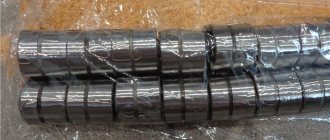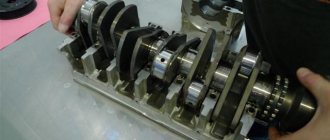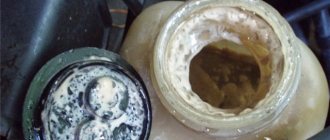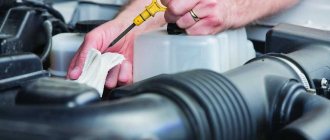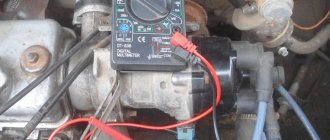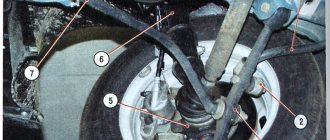The hydraulic compensator (HC) in the VAZ 2112 21124/21126 engine is the most important component of a car engine. Their use on the VAZ-2112 engine makes it possible not to periodically check thermal clearances, as on 8-valve VAZ engines. It eliminates the thermal gap between the valve lifter and the camshaft cam. Eliminating this gap allows you to ensure uninterrupted operation of the engine at the level of design parameters. During operation, if the operating conditions and instructions of the manufacturer are not observed, premature wear of this part occurs. At the same time, a characteristic knocking sound is heard in the engine. This sound tells us that the hydraulic compensator has failed and needs to be replaced. The reasons for failure of the hydraulic compensator may be the following:
• Contamination of the oil supply channels in the engine.
• Wear of the working surfaces of the check valve and plunger pair. • The occurrence of shock loads as a result of non-filling or partial filling of the hydraulic compensator with oil, in other words – its “airing”. Now let’s briefly go over each of the above points. The oil passages of the engine lubrication system must not be allowed to become contaminated. This is a clear violation of operational standards that can lead to serious consequences. The reasons for contamination of the oil passages may be:
• Using motor oil that does not comply with the instructions. • Untimely replacement of engine oil. • Malfunction of the oil filter.
As for increasing the seating gaps in the plunger pairs, in this case, increased oil leakage will occur from the high pressure chamber. In this case, the compensator will lose its resistance force and the effectiveness of the force of pressing the cam on the valve stem of the gas distribution mechanism will decrease. The internal space of the hydraulic compensator must be completely filled with oil. If this condition is not met, then the GC will not eliminate the gap in the parts of the gas distribution mechanism. As a result, dynamic loads will arise, in other words, shocks, which will lead to rapid wear of timing parts and a significant deterioration in engine performance. It should be remembered that malfunctions in the operation of the main engine can also be caused by the ingress of small particles into it with the oil, which appear as a result of wear of engine parts. In this case, the node may jam. If you do hear the aforementioned knock, then you should not immediately dramatize this event. The price for carrying out work to replace hydraulic compressors of a VAZ 2112 or Priora 16 valves in a car service center will fluctuate around 3,000 rubles, however, such work can be done with your own hands, you only need to strictly follow our detailed instructions below.
What it is?
The part is a small hydraulic device. It automatically eliminates the effects of linear expansion in the valve train mechanism during engine operation as parts expand.
The gaps are adjusted using the oil pressure in the engine. The gap is adjusted between the valve and the camshaft. With the help of such compensation of thermal gaps, the engine does not lose dynamic characteristics, fuel consumption is optimal after warming up. Also, due to the presence of hydraulic compensators in the VAZ-2112, the engine is quieter than similar engines with a mechanical valve adjustment system.
How did they appear?
The hydraulic compensator on VAZ cars has replaced ineffective mechanical adjustments of the timing mechanism. Often a regular valve on classic VAZ engines is not equipped with a compensator. Therefore, drivers adjusted valve clearances every 10 thousand kilometers. The work had to be done manually. The valve cover was removed, measurements were taken with a feeler gauge and the required gap was set.
If the driver did not adjust the valves, the engine operation was accompanied by loud noise, dynamics were lost, and fuel consumption increased. After about 50 thousand kilometers, the valves required replacement, as they were severely worn. As an alternative to mechanical adjustment, AvtoVAZ decided to offer a more modernized design.
On engines for front-wheel drive cars, special pushers were installed in front of the valve. A “hat” was put on the valve. The diameter of the pusher is large enough, and due to this, wear has been reduced. It takes longer for a larger diameter to wear out. Yes, the wear rate has decreased, but the need to adjust the valves remains, although now it has to be done less often.
Typically, tuning consisted of adding tuning washers, which decreased or increased the height of the pusher. This adjustment, despite its archaic nature, is quite effective, and some automakers use this method to this day. Valve clearances in such a mechanism need to be adjusted once every 50 thousand kilometers. On some foreign cars, pushers can live even longer.
Among the advantages of this solution are the simplicity of the design, the absence of oil requirements - even mineral oil will do. In addition, the design turned out to be very cheap. Among the disadvantages, reviews note that if the washer has worked, then the engine becomes noisy, fuel consumption increases, and dynamics decrease. AvtoVAZ thought about a design that would automatically regulate thermal clearances in the valve mechanism.
And so, instead of mechanical adjustments, VAZ-2112 hydraulic compensators appeared. At that time it was a completely new technology. In fact, everything is very simple - the driver no longer needs to manually adjust the gaps. The hydraulic compensators themselves will automatically select the desired parameter for each valve.
Sequence of operations
To replace the hydraulic compensators of the VAZ 2112 and other models, you need to drive the car into an inspection hole, drive onto an overpass, or lift it with a jack. It is important to ensure reliable fixation of the vehicle and sufficient illumination of the work area. Now you can start working:
- For safe work, you need to turn off the on-board power supply; to do this, disconnect the negative terminal from the battery.
- Removing the plastic engine shield - unscrew the four bolts.
Now you need to loosen the mount of the generator on the mounting plate; to do this, loosen the nut.
You need to remove the generator drive tension belt. To do this, loosen its tension by rotating the nut counterclockwise.
- Removing the engine intake manifold and receiver. The hole must be closed to prevent dirt and foreign objects from getting into them.
- Then you need to dismantle the right wheel and the plastic shield covering the engine compartment. Now use the pulley bolt to turn the crankshaft clockwise.
- The lower pulley rotates to the camshaft timing pulley mark to the antennae on the rear timing cover.
- The camshaft pulley fastenings are loosened and the timing belt is removed.
To completely dismantle the camshaft pulleys, you need to check the marks on the timing belt housing. They must line up exactly with the marks on the pulleys.Using the heads, 15 fasteners of the cylinder head cover are unscrewed.
Now twenty fasteners of the camshaft bearing housing are unscrewed.
The camshaft bearing housing is removed.
- The camshaft is completely removed, along with the seals.
- A magnetic screwdriver is applied to the end of the hydraulic pusher, so it is removed from the head socket.
New spare parts are installed in place of the old compensators in the cylinder head sockets. - The cams and bearing journals are lubricated with oil, the shafts are installed in the head supports. Note! To easily distinguish the intake camshaft from the exhaust device, there is a belt on its first journal.
- Now you need to tighten the nuts until they touch the cylinder head of the bearings. The operation is performed in a certain sequence, it is shown in the figure.
- The valve cover, timing belt and pulleys are returned to their original locations. Further operations are performed in reverse order.
Principle of operation
The hydraulic compensator is an intermediate part between the valve and the camshaft cam. When the cam does not exert pressure on the compensator, the valve is closed under the action of the cylinder head spring. Inside, a spring presses on the parts of the plunger pair. Due to this, the compensator body moves towards the camshaft cam until it completely rests against it. In this case, the gap will be minimal.
The required pressure inside the plunger pair is exerted due to oil pressure. It is fed through channels into the cylinder head and then passes through the holes in the compensator. Then inside it bends the valve and creates the necessary pressure.
Next, the cam goes down and presses on the compensator. The oil inside the plunger presses on the valve and closes it. The compensator turns into a rigid element, which, under the pressure of the cam, opens the valve of the timing mechanism.
It must be said that the hydraulic compensators on the VAZ-2112 (16 valves) are quite highly efficient devices. The oil is squeezed out of the plunger before the ball closes. So, a very slight gap may form, which will go away the next time the oil is supplied. The compensator will become rigid again.
It doesn’t matter to what temperature the engine is heated: the gap will always be the most optimal. The mechanism does not require adjustments during its entire service life. Even if there is wear, adjustment is not necessary. The compensator is always pressed against the camshaft.
Step-by-step process for replacing hydraulic compressors
1
.
The car is fixed on a flat surface, the hand brake is put on, and wheel chocks can be placed under the wheels. 2
.
Disconnects the negative terminal from the battery. 3
. Remove the engine cover by unscrewing the four bolts.
If the bolts are not corroded, they will come out easily.
4
. Then remove the receiver. Please note that after this, all inlet openings must be covered with a clean rag to prevent dirt and other foreign objects from entering.
take the receiver to the side.
5
.
We remove the ignition module, which is held on by three bolts. It will be useful to visually check it for damage, since this is a disease of this node. 6
.
Next, loosen the clamps and move the crankcase ventilation hose to the side. 7
.
Remove the injector power supply clamp. 8
. The next step is to remove the valve cover of the “head”; to do this, you need to unscrew 15 bolts located around the perimeter.
The location of the bolts is indicated by a marker.
9
.
When it is dismantled, we see a general view of two camshafts and all its components. 10
. If you want to check which specific hydraulic compensator is faulty, just press on it. If pressing occurs with significant force, it is in good condition, and when it gives in easily, it must be replaced.
A regular screwdriver is suitable for checking.
eleven
.
To proceed to the next step, you need to remove the timing belt; how to do this is written in great detail in this article on replacing the VAZ 16 valve timing belt. Also read the material on how to properly tension the timing belt. 12
. When the belt is removed, unscrew the bolts and remove the camshaft drive gears and the crankshaft pulley.
Carefully remove the dismantled pulleys to the side.
13
.
Remove the terminal from the oil pressure sensor. 14
. Carefully unscrew the 20 bolts that secure the housing above the camshafts.
Unscrew it as indicated by the arrows.
15
. Then we remove the nut that secures the shaft support bracket on the rear side of the engine.
To dismantle the nuts, you need to twist.
16
.
We remove the entire body to the side. 17
. Now that access to the camshafts is open, we remove and put them away, not forgetting to set them again according to the marks.
When dismantling, pay attention to the integrity of the seals.
18
.
Now we can start replacing the hydraulic compressors, and here we will need a good magnet. 19
. Using a magnet, we take out all the old elements and put new ones in their place.
We choose a magnet so that its strength is sufficient for a hook.
20
.
We carry out the assembly process in the same order as removal, not forgetting to change the gaskets and apply sealant where necessary, paying attention to the joints and connections. 21
.
We set the marks and put on the timing belt. 22
. We remove the remains of the dried sealant, connect all the devices, and at this point the work on replacing the hydraulic compressors can be considered complete.
Causes of sound
One of the most basic reasons is related to the quality and level of engine oil. So, most often a knock is heard due to insufficient level. Oil flows ineffectively into the oil channels and does not enter the plunger pair. As a result, there is no necessary pressure in the hydraulic compensator for its full operation.
The oil channels in the cylinder head or in the compensator itself may also be clogged. This happens due to untimely oil changes. It burns, and carbon deposits form on the walls of the mechanism. The latter can clog the channels of the lubrication system. Oil is not able to effectively flow inside the hydraulic compensator.
Mechanical problems can also be identified. Most often, the hydraulic compensator on the VAZ-2112 (16 valves) knocks due to the failure of the plunger pair - these elements are jammed. There will be a knock if the ball valve in the plunger has failed. The sound may also indicate carbon deposits on the outer part of the plunger body. It does not allow the mechanism to move and automatically adjust the gap.
Signs of knocking hydraulic compensators when hot
It is very important for a car enthusiast to know how to understand that one or more hydraulic compensators are knocking. After all, its knocking can easily be confused with other sounds due to problems with the piston pin, crankshaft liners, camshaft or other parts inside the engine.
The knocking of hydraulic compensators when hot can be diagnosed by opening the hood. The sounds will start coming from under the valve cover. The tonality of the sound is specific, characteristic of metal parts hitting each other. Some compare it to the sound of a chirping grasshopper. What is typical is that knocking from faulty compensators occurs twice as often as the engine speed. Accordingly, when the engine speed increases or decreases, the knocking sound from the hydraulics will behave accordingly. When you release the gas, you will hear sounds as if your valves are not adjusted.
How to solve the problem?
The most effective solution is to replace the hydraulic compensators on the VAZ-2112. But if carbon deposits have formed in the system, then these mechanisms are removed and washed. After washing, it is sometimes possible to restore their functionality. However, if the car has high mileage, then the compensator breaks and then only needs to be replaced.
The quality of the mechanism largely depends on what kind of oil is poured into the engine and how often it is changed. For quiet and reliable operation of the automatic thermal gap compensation mechanism, it is necessary to fill in high-quality synthetic oil and change it regularly. Then the elements will last longer. Sometimes a less viscous oil may be required to increase the pressure in the system.
